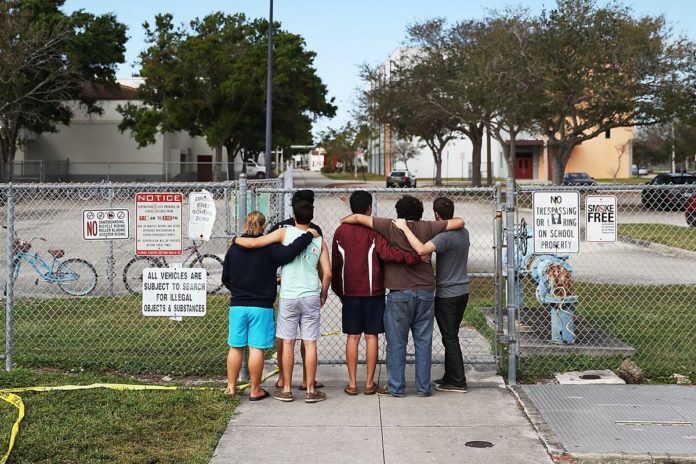On May 7, another surge of school violence splashed across national headlines: one dead, eight wounded in a Colorado charter school shooting. Not just any school … one located a few miles from Columbine High, which put school shootings on our collective national radar 20 years ago.
Closer to home, Monroe County Schools have been taking a serious look at preventive measures, especially in the aftermath of the Marjory Stoneman Douglas High School shooting in Parkland, Florida in February 2018. In its wake, the Florida legislature passed the Marjory Stoneman Douglas High School Public Safety Act, and thus the Florida Department of Education adopted best practices for school safety.
Just a few weeks ago, a Key West High School student came to school with a loaded handgun, leading to his expulsion and more public scrutiny on safety in Keys schools. We caught up with Superintendent Mark Porter as well as Keys high school principals to talk about the ways our schools are approaching safety in a time of increased gun violence.
While Monroe County only expels a handful of students annually, and often not for weapons or violence, it is an apt time to reevaluate school preventive policy. So what do we already have in place to get ahead of school violence?
School resource officers
“We have a school resource officer or a school security officer on all 16 campuses each and every day,” said Porter. “They aren’t mere security guards — they engage in the culture and fabric of the school.” While the school district used to share the cost of the officers with the sheriff’s department, with the additional millage this year, the school district is paying the expense of the SROs in full.
Principal Blake Fry of Coral Shores High School said SROs provide an invaluable resource, and they’re an intricate part of the school’s staff.
“They not only provide the safety and security and expertise of their profession here on the campus, but they are part of the Coral Shores community and play a significant role in the culture and relationships of students and staff here,” he said.
Fry said current SRO Jose Costoya provides additional support at extra- curricular events, classroom instruction and supports the building, district, and state safety and security initiatives on a daily basis.
“The relationships that our SROs build with students provide another layer of security that would not exist without their presence on campus,” Fry said.
Mental health resources
The Monroe County school system now has four social workers dedicated to attending to the mental and emotional health of students. They also have partnered with the Guidance Care Center to have a trained mental health professional at least once a week in every school. While that isn’t constant, it does mean that a professional is available on a regular basis for student support. Two social workers are in the Lower Keys, one in the Middle, and one in the Upper Keys.
Porter said that another change is “how we prioritize on the mental health. We opened this past school year with an all-employee gathering in Marathon, and half of that day had to do with mental health of students and staff. The county has also trained nearly 250 of our employees in a six hour training called ‘Youth Mental Health First Aid.’”
Key West High School Principal Amber Acevedo said, “What has increased with mental health, in partnership with the Guidance Care Center, is a mobile response team. Now, if students come to us and say ‘I need something,’ then we know who to refer them to, and now we have more tools.”
Hardening the schools
One policy adopted after 2019 spring break that came under fire was the locked classroom door policy — teachers must lock classrooms from the inside during class.
“To be honest, we were a little bit reluctant to move forward with this policy, when many other schools did,” said Porter. “The overwhelming statistic is that of 46 school intruder incidents, not a single intruder has breached a classroom door.” The district also considered transparent backpacks, a policy that Stoneman Douglas adopted and then dropped because of the difficulty with enforcement.
Marathon High School Prinicipal Wendy McPherson said the security measures outlined by the school board have been implemented at Marathon.
“Putting the fencing around campus to control who comes and goes has been one of the most effective parts of the plan,” said McPherson, adding that the fencing plan is evolving. “But I also strongly believe in training,” McPherson said. “You can have 101 safety measures in place, but unless people are trained and used to taking action, it does us no good.”
Safety measures at Stanley Switlik Elementary are perhaps better in part because of the massive $23 million reconstruction underway. “Our new campus will have the physical safety features built in. In fact, our temporary campus already has them, too,” said principal Brett Unke. Parents and school partners must pass through a single “portal” to gain access to the institution.
The district has not adopted use of metal detectors in Monroe County schools.
Drills and tips
All of the schools implement drills in order to be prepared for an “intruder,” or active shooter situation.
“There is a balance to be struck in our drills, especially in places like elementary schools,” said Porter. He discusses hypothetical conversations with students and staff: What would you do were someone to enter this classroom from X? How can you follow “Run, Hide, Fight” here? Some of these exercises can take place without moving desks or physically hiding. “My elementary school teachers come to me all the time: we want to be sure we are prepared but maintain a balance of what’s age appropriate.”
The district has also implemented an anonymous text line, School Text Tips, introduced by local software developer Shawn Verne, who offered the service as a pilot to Sugarloaf and Key West High Schools for free. Now it’s used county-wide.
It’s a dedicated text line, where students may send tips anonymously, and they are shared with administrators and the SRO. It has since become a tool to report not only potentially violent situations, but also the mental or emotional health of fellow students, allowing schools to get ahead of distress or self-harm.
“We are getting students to realize that our best safety defense is each other. We feel this is one of the best ways to prevent incidents,” said Acevedo.
What about guns?
At the end of the day, there is a common denominator, and it isn’t just schools; it’s also guns. The Florida House just passed a “guardian” program last week, allowing teachers to volunteer — pending district approval — to bring firearms to school. Gov. Ron DeSantis still has to sign the bill into law.
“It allows the good guys to stop the bad,” said Republican Rep. Chuck Brannan of Lake City, a retired law enforcement officer.
Porter disagrees. “I don’t think the answer is more guns on a school campus. I am vehemently opposed to that.”
Acevedo took a more philosophical stance: “My personal opinion is that teachers and educators need to be doing just that — our job is to educate; that’s what we should be focused on.”




















